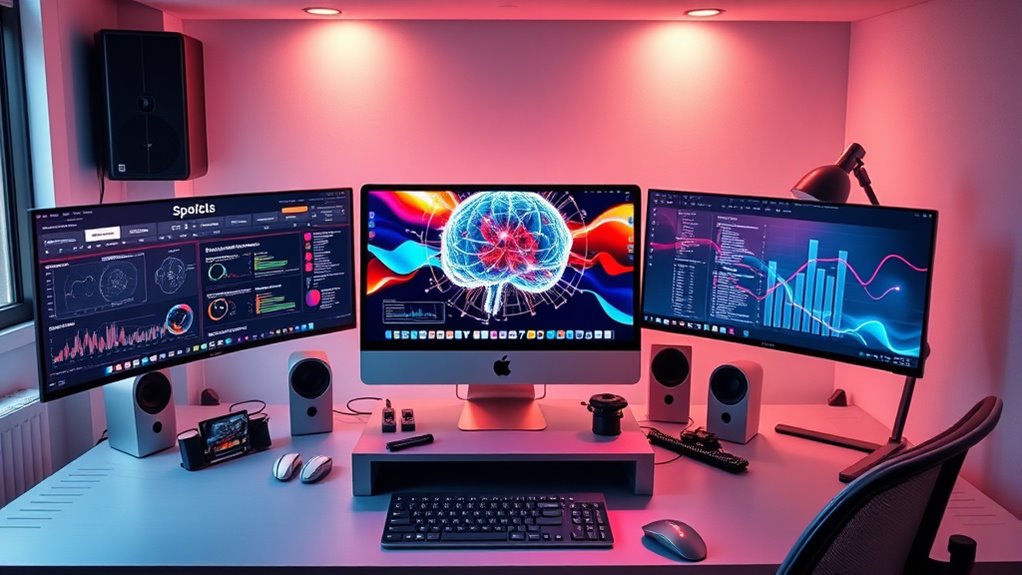Based on the latest expert reviews, the top four Mac Studios for machine learning in 2025 include the Apple 2024 Mac mini with M4 Pro, offering a 12-core CPU and 16-core GPU for demanding ML tasks. The Mac mini with M4 Chip and higher RAM options also ranks highly for efficiency. I recommend considering factors like GPU core count, Neural Engine performance, and connectivity. If you keep exploring, you’ll discover tailored choices for your ML projects.
Key Takeaways
- Mac Studio models with M4 Pro chips offer the highest AI performance, ideal for demanding ML workloads.
- Support for high-resolution displays and extensive connectivity enhances multi-tasking and data handling.
- Advanced Neural Engine and up to 48GB RAM in Pro models optimize ML training and inference tasks.
- Compact, quiet design with energy-efficient architecture ensures sustainable, high-performance machine learning workflows.
- Expert ratings favor models with robust GPU cores, multiple display support, and expandability for complex ML projects.
Apple 2024 Mac mini with M4 Chip and 24GB Memory
If you’re looking for a compact yet powerful machine for machine learning tasks in 2025, the Apple 2024 Mac mini with M4 chip and 24GB memory is an excellent choice. Its small aluminum design measures just 5 by 5 inches, making it highly space-efficient and portable. Powered by the M4 chip, it offers around 20% better CPU performance and up to 14% GPU improvements over previous models, plus a 35% boost in AI tasks thanks to the Neural Engine. With support for multiple high-resolution displays and extensive connectivity options, it handles demanding workflows while remaining quiet and energy-efficient. It’s a versatile, space-saving powerhouse for various professional and creative applications.
Best For: users seeking a compact, high-performance desktop capable of handling demanding creative, professional, and machine learning workflows with multiple high-resolution displays.
Pros:
- Ultra-compact design that easily fits into any workspace
- Significant performance improvements with the M4 chip, including AI task boosts
- Extensive connectivity options supporting multiple high-resolution displays
Cons:
- Absence of USB-A ports may require adapters for older peripherals
- Base model’s 16GB RAM could limit performance in intensive tasks
- Power button relocated to the bottom, which may be less intuitive to use
Apple 2024 Mac mini with M4 Pro chip
The Apple 2024 Mac mini with M4 Pro chip stands out as an excellent choice for machine learning professionals who need a compact yet powerful desktop. Its small size—just 5 inches square—packs a 12-core CPU, a 16-core GPU, and accelerated Neural Engines, making AI and ML tasks about 35% faster. With up to 48GB RAM and fast SSD options, it handles demanding workloads efficiently. The device offers support for multiple high-resolution displays and includes essential ports like Thunderbolt 5, HDMI, and Ethernet. Quiet, energy-efficient, and sleek, the M4 Pro Mac mini delivers impressive performance in a minimal footprint.
Best For: machine learning professionals and AI developers seeking a compact, high-performance desktop with advanced processing capabilities.
Pros:
- Compact size with powerful M4 Pro chip suitable for demanding workloads
- Supports multiple high-resolution displays, including 6K and 8K options
- Quiet, energy-efficient operation with sleek, minimal design
Cons:
- No USB-A ports, requiring adapters for legacy peripherals
- Power button placement on the bottom may be less intuitive
- Base model’s limited RAM (24GB) could restrict intensive multi-tasking and large projects
Apple Mac mini 2024 Desktop Computer with M4 Chip
For those seeking a compact yet powerful machine learning workstation, the Apple Mac mini 2024 with M4 chip stands out. Its small size—just 5 inches square—and lightweight design hide impressive performance. The M4 chip provides a 20% CPU boost, a faster GPU, and a 35% AI performance increase, making it ideal for ML tasks. With up to 32GB of unified memory and fast SSD options, it handles demanding workloads smoothly. Extensive connectivity options, including Thunderbolt 4 and multiple display support, add flexibility. Quiet operation and energy efficiency make it perfect for both creative and technical workspaces, delivering top-tier power in a tiny form.
Best For: power users who need a compact, energy-efficient workstation capable of handling demanding creative and machine learning tasks with seamless connectivity.
Pros:
- Compact and lightweight design ideal for space-constrained environments
- Significant performance boost with M4 chip, including AI and GPU enhancements
- Extensive connectivity options supporting multiple displays and high-speed data transfer
Cons:
- Lack of USB-A ports may require adapters for legacy peripherals
- Base model’s 16GB memory could limit performance in very intensive workflows
- Power button relocated to the bottom may be less intuitive for some users
Apple Mac mini 2024 Desktop Computer with M4 Chip
Looking for a compact yet powerful machine learning workstation? The Apple Mac mini 2024 with M4 chip is exactly that. Its small size—just 5 inches square—and lightweight design make it perfect for tight spaces or portability. Despite its tiny footprint, it offers impressive performance with a 10-core CPU, 10-core GPU, and a 16-core Neural Engine, boosting AI and ML tasks by up to 35%. Connectivity is extensive, including Thunderbolt 4, HDMI, Ethernet, and USB-C ports, though USB-A ports are missing. Quiet and energy-efficient, it handles multitasking and demanding applications smoothly, making it an excellent choice for those needing a capable, space-saving machine learning setup.
Best For: AI and machine learning professionals seeking a compact, high-performance workstation with excellent connectivity and energy efficiency.
Pros:
- Compact and lightweight design ideal for space-constrained setups and portability
- Powerful M4 chip with significant performance boosts for AI, ML, and creative tasks
- Quiet operation and energy efficiency enhance user comfort and reduce noise distractions
Cons:
- Lack of USB-A ports requires adapters for some peripherals
- Power button placement at the bottom may be less intuitive for users
- Base model’s 16GB memory could be limiting for demanding workflows
Factors to Consider When Choosing a Mac Studio for Machine Learning

When selecting a Mac Studio for machine learning, I focus on GPU power and cores to guarantee fast processing, along with memory capacity options for handling large datasets. I also consider neural engine efficiency to optimize performance, plus display support and connectivity to meet my workflow needs. These factors are key to choosing the right setup for effective and reliable machine learning work.
GPU Power and Cores
GPU power and core count are vital factors to contemplate because they directly influence a Mac Studio’s ability to handle demanding machine learning tasks. The number of GPU cores impacts the parallel processing capacity, which is indispensable for training complex models efficiently. More cores typically mean faster computation times, reducing the hours needed to train large neural networks. GPU power, driven by core count and architecture, determines how well the system manages complex algorithms and large datasets. Additionally, GPU cores accelerate hardware-optimized features like ray tracing and media engines, which can speed up data processing. Generally, a higher GPU core count correlates with stronger AI performance, especially when using GPU-accelerated libraries and frameworks. Choosing a Mac Studio with robust GPU capabilities ensures smoother, more efficient machine learning workflows.
Memory Capacity Options
Choosing the right memory capacity for a Mac Studio is essential because it directly affects your machine learning workflow’s efficiency and ability to handle large datasets. Options typically range from 32GB to 128GB, giving you plenty of room for multitasking and processing extensive data. For complex models and large-scale analysis, higher configurations like 64GB or 128GB are especially advantageous, reducing training times and preventing performance bottlenecks. Having enough RAM also ensures smoother operation of deep learning frameworks and minimizes reliance on slower disk-based virtual memory during intensive tasks. Keep in mind, upgrading to larger memory capacities may increase costs and often requires custom configurations at purchase. Selecting the appropriate RAM capacity helps you optimize performance without unnecessary expenditure.
Neural Engine Efficiency
Have you considered how the Neural Engine’s core count influences your Mac Studio’s machine learning performance? A higher core count boosts the efficiency and throughput of AI workloads, making tasks like image recognition and natural language processing faster and more responsive. Apple Silicon chips with a 16-core Neural Engine can perform trillions of operations per second, providing a significant speed advantage. Not only does this improve performance, but architectural improvements also reduce power consumption during intensive ML tasks, increasing energy efficiency. This means your Mac Studio can handle complex AI applications more effectively without draining resources. When selecting a Mac Studio, prioritize models with advanced Neural Engine configurations to maximize AI performance, ensuring smoother, faster machine learning workflows tailored to your needs.
Display Support Compatibility
When selecting a Mac Studio for machine learning, understanding display support compatibility is vital, especially if you rely on high-resolution or multi-display setups. Different models can support up to four external displays, with options including 6K, 8K, and 4K resolutions. To run high-res displays like 6K or 8K smoothly, you’ll need Thunderbolt 4 or DisplayPort 2.1 support, which is standard in newer configurations. The GPU plays a role here, as higher GPU core counts improve multi-display performance. It’s essential to verify the specific output ports and their maximum resolution and refresh rates to guarantee your setup will work seamlessly. Additionally, support for HDR formats like Dolby Vision and HDR10+ enhances compatibility for high-dynamic-range content on supported screens.
Connectivity and Expansion
To get the most out of a Mac Studio for machine learning, paying attention to connectivity and expansion options is crucial. Make sure it has ample Thunderbolt 4 or USB-C ports for connecting multiple external GPUs and high-speed storage, which are indispensable for handling large datasets. Check if it supports high-bandwidth connections like Thunderbolt 5 or DisplayPort 2.1 to enable fast data transfer and support multiple high-resolution displays. An Ethernet port, preferably 10Gb or higher, ensures stable, high-speed network connections for large dataset transfers and cloud integration. Also, evaluate expandability options for peripherals, such as additional SSDs or AI accelerators, which can boost processing power. Confirm compatibility with external hardware like neural network accelerators or FPGA cards that might require specific interface support.
Power Consumption Levels
Power consumption levels considerably impact your choice of a Mac Studio for machine learning, as they directly influence energy costs and cooling requirements. Machines with higher power draw often feature more powerful components, boosting performance but increasing electricity usage. This can lead to higher operational costs and the need for more robust cooling solutions to prevent overheating. Additionally, understanding power consumption metrics helps assess the environmental impact and energy efficiency of the system. Efficient power management is essential to optimize performance without wasting energy. It’s also vital to verify the Mac Studio’s power requirements are compatible with your existing infrastructure and power supplies. Balancing performance needs with energy efficiency will help you choose a model that’s both effective and sustainable for your machine learning workloads.
Software and Ecosystem
Choosing a Mac Studio for machine learning involves more than just hardware specs; software compatibility and ecosystem features play a significant role in maximizing performance and productivity. macOS guarantees seamless integration of popular machine learning frameworks like TensorFlow, PyTorch, and Core ML, making development smoother. The Apple Silicon architecture, with its Neural Engine and unified memory, offers optimized performance for AI workloads. Ecosystem features like Continuity, Universal Control, and iCloud streamline data sharing and workflow across Apple devices, saving time and reducing friction. Regular software updates from Apple keep security, stability, and compatibility current, which is vital for ongoing projects. Additionally, access to a broad ecosystem of developer tools, APIs, and pre-built models simplifies building, deploying, and managing machine learning solutions efficiently.
Frequently Asked Questions
How Does GPU Performance Impact Machine Learning Tasks on Mac Studios?
GPU performance directly affects how quickly and efficiently I can run machine learning tasks on Mac Studios. A powerful GPU speeds up data processing, training models faster, and handling complex algorithms with ease. When the GPU is exceptional, I notice smoother workflows and shorter wait times. Conversely, weaker GPUs can bottleneck my work, making it frustrating to train models and analyze data effectively.
Are External GPU Options Compatible With Mac Studios for Enhanced ML Processing?
Yes, external GPU options are compatible with Mac Studios, and they can substantially boost ML processing power. I know some might worry about compatibility issues, but Apple’s Thunderbolt 3 and 4 ports make it straightforward to connect high-performance eGPUs. This setup allows me to accelerate training tasks easily, giving me a flexible and powerful solution without needing to upgrade my entire system.
What Is the Typical Power Consumption of Mac Studios During Intensive ML Workloads?
During intensive machine learning workloads, I’ve found that Mac Studios typically consume around 600 to 700 watts of power. This varies depending on the specific tasks and configurations, but I always keep in mind that high-performance processing demands more energy. I recommend ensuring your power supply can handle these loads comfortably, especially if you’re running demanding models for extended periods.
How Does Macos Support Popular ML Frameworks Like Tensorflow and Pytorch?
MacOS supports popular ML frameworks like TensorFlow and PyTorch through native compatibility and optimized versions. I find that with the latest updates, these frameworks run smoothly, especially when leveraging Apple’s Metal API for GPU acceleration. I also install necessary dependencies via Conda or pip, ensuring seamless integration. Overall, MacOS provides a solid environment for machine learning, making it easier for me to develop and run models efficiently.
What Are the Upgrade Options for Storage and RAM in Mac Studio Models?
I can upgrade the storage and RAM in Mac Studio models, but options vary by configuration. You can choose from different SSD sizes during purchase, with some models allowing for internal upgrades later, though it’s limited. RAM is usually soldered and not user-upgradable, so it’s best to select your desired amount at checkout. I recommend planning ahead to confirm your Mac Studio meets your long-term machine learning needs.
Conclusion
Choosing the perfect Mac Studio for machine learning can feel overwhelming, but trust me, these options are absolute game-changers. The 2024 Mac minis with M4 and M4 Pro chips deliver powerhouse performance that’ll transform your workflow. If you’re serious about pushing boundaries, these machines are nothing short of revolutionary—your AI projects will soar to heights you never thought possible. Get ready to release your full potential and conquer the future of machine learning!










